Njengamartin399
On this page, you find all documents, package deals, and flashcards offered by seller njengamartin399.
- 141
- 0
- 7
Community
- Followers
- Following
148 items

Provision of a Safe Environment
1. The nurse is caring for a patient in isolation due to a communicable infection. Which personal protective equipment (PPE) should the nurse don before entering the patient’s room? • A) Gloves and gown • B) Gloves, gown, and face shield • C) Gloves only • D) Gown and mask Answer: B Rationale: For a patient in isolation for a communicable infection, the nurse must wear gloves, a gown, and a face shield if there is any risk of contact with bodily fluids. 2. What is the most effec...
- Exam (elaborations)
- • 17 pages •
1. The nurse is caring for a patient in isolation due to a communicable infection. Which personal protective equipment (PPE) should the nurse don before entering the patient’s room? • A) Gloves and gown • B) Gloves, gown, and face shield • C) Gloves only • D) Gown and mask Answer: B Rationale: For a patient in isolation for a communicable infection, the nurse must wear gloves, a gown, and a face shield if there is any risk of contact with bodily fluids. 2. What is the most effec...
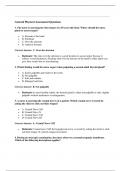
Health and Physical Assessment of the Adult Client
1. The nurse is assessing the skin turgor of a 45-year-old client. Where should the nurse pinch to assess turgor? • A. Dorsum of the hand • B. Forehead • C. Over the sternum • D. Anterior forearm Correct Answer: C. Over the sternum • Rationale: The skin over the sternum is a good location to assess turgor because it reflects overall hydration. Pinching skin over the dorsum of the hand in older adults can give false results due to skin thinning. 2. Which finding would the nurse e...
- Exam (elaborations)
- • 19 pages •
1. The nurse is assessing the skin turgor of a 45-year-old client. Where should the nurse pinch to assess turgor? • A. Dorsum of the hand • B. Forehead • C. Over the sternum • D. Anterior forearm Correct Answer: C. Over the sternum • Rationale: The skin over the sternum is a good location to assess turgor because it reflects overall hydration. Pinching skin over the dorsum of the hand in older adults can give false results due to skin thinning. 2. Which finding would the nurse e...
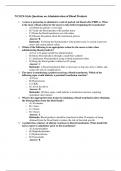
Administration of Blood Products
1. A nurse is preparing to administer a unit of packed red blood cells (PRBCs). What is the most critical action for the nurse to take before beginning the transfusion? o A) Obtain the patient’s vital signs o B) Verify the blood product with another nurse o C) Prime the blood transfusion set with saline o D) Educate the patient about the transfusion process Answer: B Rationale: Verifying the blood product with another nurse is crucial to prevent errors and ensure patient safety. 2. Whic...
- Exam (elaborations)
- • 12 pages •
1. A nurse is preparing to administer a unit of packed red blood cells (PRBCs). What is the most critical action for the nurse to take before beginning the transfusion? o A) Obtain the patient’s vital signs o B) Verify the blood product with another nurse o C) Prime the blood transfusion set with saline o D) Educate the patient about the transfusion process Answer: B Rationale: Verifying the blood product with another nurse is crucial to prevent errors and ensure patient safety. 2. Whic...
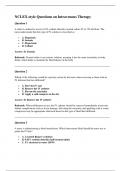
Intravenous Therapy
Question 1 A client is ordered to receive 0.9% sodium chloride (normal saline) IV at 125 mL/hour. The nurse understands that this type of IV solution is classified as: • A. Hypotonic • B. Isotonic • C. Hypertonic • D. Colloid Answer: B. Isotonic Rationale: Normal saline is an isotonic solution, meaning it has the same osmolarity as body fluids, which helps to maintain the fluid balance in the body. ________________________________________ Question 2 Which of the following would...
- Exam (elaborations)
- • 23 pages •
Question 1 A client is ordered to receive 0.9% sodium chloride (normal saline) IV at 125 mL/hour. The nurse understands that this type of IV solution is classified as: • A. Hypotonic • B. Isotonic • C. Hypertonic • D. Colloid Answer: B. Isotonic Rationale: Normal saline is an isotonic solution, meaning it has the same osmolarity as body fluids, which helps to maintain the fluid balance in the body. ________________________________________ Question 2 Which of the following would...
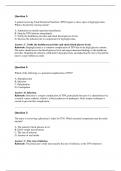
Total Parenteral Nutrition (TPN)
A patient receiving Total Parenteral Nutrition (TPN) begins to show signs of hyperglycemia. What is the priority nursing action? A. Administer an insulin injection immediately. B. Stop the TPN infusion immediately. C. Notify the healthcare provider and check blood glucose levels. D. Increase the infusion rate to compensate for hyperglycemia. Answer: C. Notify the healthcare provider and check blood glucose levels. Rationale: Hyperglycemia is a common complication of TPN due to the high glu...
- Exam (elaborations)
- • 23 pages •
A patient receiving Total Parenteral Nutrition (TPN) begins to show signs of hyperglycemia. What is the priority nursing action? A. Administer an insulin injection immediately. B. Stop the TPN infusion immediately. C. Notify the healthcare provider and check blood glucose levels. D. Increase the infusion rate to compensate for hyperglycemia. Answer: C. Notify the healthcare provider and check blood glucose levels. Rationale: Hyperglycemia is a common complication of TPN due to the high glu...
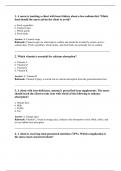
Nutrition
1. A nurse is teaching a client with heart failure about a low-sodium diet. Which food should the nurse advise the client to avoid? a. Fresh vegetables b. Canned soups c. Whole grains d. Fresh fruits Answer: b. Canned soups Rationale: Canned soups are often high in sodium and should be avoided by clients on low-sodium diets. Fresh vegetables, whole grains, and fresh fruits are generally low in sodium. ________________________________________ 2. Which vitamin is essential for calcium abso...
- Exam (elaborations)
- • 19 pages •
1. A nurse is teaching a client with heart failure about a low-sodium diet. Which food should the nurse advise the client to avoid? a. Fresh vegetables b. Canned soups c. Whole grains d. Fresh fruits Answer: b. Canned soups Rationale: Canned soups are often high in sodium and should be avoided by clients on low-sodium diets. Fresh vegetables, whole grains, and fresh fruits are generally low in sodium. ________________________________________ 2. Which vitamin is essential for calcium abso...

Vital Signs and Laboratory Values
1. What is the normal range for adult resting heart rate? A) 40-60 bpm B) 60-100 bpm C) 100-120 bpm D) 120-160 bpm Answer: B Rationale: The normal resting heart rate for adults is typically between 60 and 100 beats per minute (bpm). 2. A patient’s blood pressure is recorded at 130/85 mmHg. This reading is classified as: A) Normal B) Elevated C) Hypertension Stage 1 D) Hypertension Stage 2 Answer: C Rationale: A blood pressure reading of 130/85 mmHg falls within the range classifie...
- Exam (elaborations)
- • 12 pages •
1. What is the normal range for adult resting heart rate? A) 40-60 bpm B) 60-100 bpm C) 100-120 bpm D) 120-160 bpm Answer: B Rationale: The normal resting heart rate for adults is typically between 60 and 100 beats per minute (bpm). 2. A patient’s blood pressure is recorded at 130/85 mmHg. This reading is classified as: A) Normal B) Elevated C) Hypertension Stage 1 D) Hypertension Stage 2 Answer: C Rationale: A blood pressure reading of 130/85 mmHg falls within the range classifie...
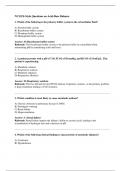
Acid-Base Balance
1. Which of the following is the primary buffer system in the extracellular fluid? A) Protein buffer system B) Bicarbonate buffer system C) Phosphate buffer system D) Hemoglobin buffer system Answer: B) Bicarbonate buffer system Rationale: The bicarbonate buffer system is the primary buffer in extracellular fluid, maintaining pH by neutralizing acids and bases. ________________________________________ 2. A patient presents with a pH of 7.30, PCO2 of 50 mmHg, and HCO3 of 24 mEq/L. This pa...
- Exam (elaborations)
- • 18 pages •
1. Which of the following is the primary buffer system in the extracellular fluid? A) Protein buffer system B) Bicarbonate buffer system C) Phosphate buffer system D) Hemoglobin buffer system Answer: B) Bicarbonate buffer system Rationale: The bicarbonate buffer system is the primary buffer in extracellular fluid, maintaining pH by neutralizing acids and bases. ________________________________________ 2. A patient presents with a pH of 7.30, PCO2 of 50 mmHg, and HCO3 of 24 mEq/L. This pa...
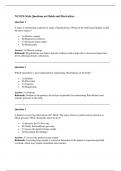
Fluids and Electrolytes
Question 1 A nurse is monitoring a patient for signs of hypokalemia. Which of the following findings would the nurse expect? • A) Muscle cramps • B) Hyperactive reflexes • C) Increased urine output • D) Bradycardia Answer: A) Muscle cramps Rationale: Hypokalemia can lead to muscle weakness and cramps due to decreased potassium levels affecting muscle contraction. ________________________________________ Question 2 Which electrolyte is most important for maintaining fluid balanc...
- Exam (elaborations)
- • 21 pages •
Question 1 A nurse is monitoring a patient for signs of hypokalemia. Which of the following findings would the nurse expect? • A) Muscle cramps • B) Hyperactive reflexes • C) Increased urine output • D) Bradycardia Answer: A) Muscle cramps Rationale: Hypokalemia can lead to muscle weakness and cramps due to decreased potassium levels affecting muscle contraction. ________________________________________ Question 2 Which electrolyte is most important for maintaining fluid balanc...
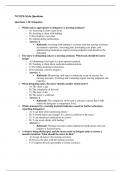
Leadership, Delegating, and Prioritizing Client Care
1. Which task is appropriate to delegate to a nursing assistant? o A) Assessing a client’s pain level. o B) Assisting a client with bathing. o C) Developing a care plan. o D) Administering medications. o Answer: B Rationale: Assisting with bathing is a routine task that nursing assistants are trained to perform. Assessing pain, developing care plans, and administering medications require nursing judgment and should not be delegated. 2. The nurse is delegating tasks to a nursing assi...
- Exam (elaborations)
- • 13 pages •
1. Which task is appropriate to delegate to a nursing assistant? o A) Assessing a client’s pain level. o B) Assisting a client with bathing. o C) Developing a care plan. o D) Administering medications. o Answer: B Rationale: Assisting with bathing is a routine task that nursing assistants are trained to perform. Assessing pain, developing care plans, and administering medications require nursing judgment and should not be delegated. 2. The nurse is delegating tasks to a nursing assi...
